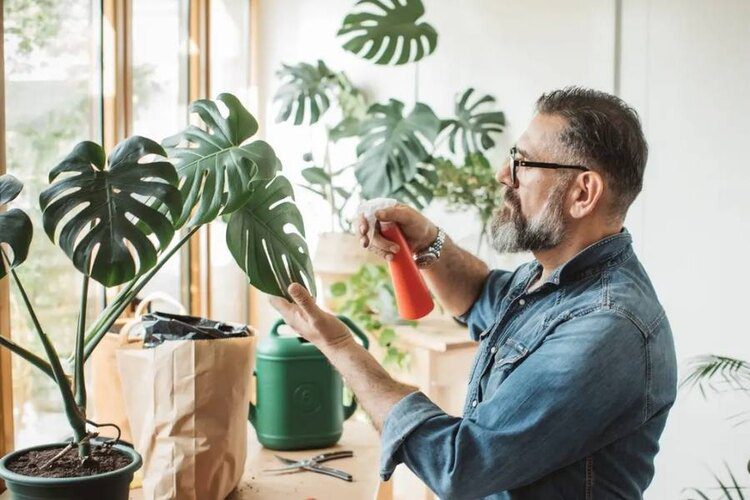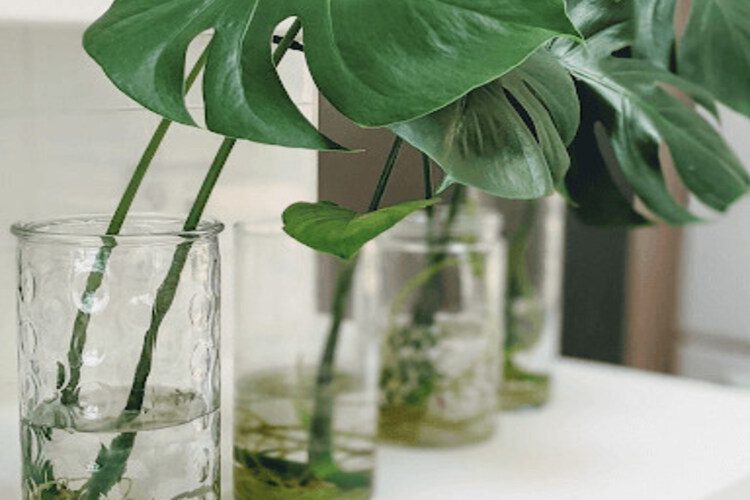23 Common Monstera Problems: Tips To Treat For Each

Monstera problems often come from insufficient natural conditions such as light, humidity, temperature, and improper care due to overwatering, exposing too much direct light, or growing it in the wrong soil. You need to know its 23 main problems to rescue in time. The most serious issue is root rot because this is the key part that feeds the entire plant. Additionally, leaves issues such as discoloration, diseases from fungi, slow growing, or not splitting are also visible signs. Let’s check these 23 problems for Monstera and methods to treat that I apply successfully.
| Problem Types | Problem Descriptions | How To Prevent |
|---|---|---|
| Leaves turning yellow | Sign of overwatering or underwatering | Provide adequate watering schedule |
| Leaves curling | Occur due to low humidity or excessive sunlight | Adjust humidity levels, avoid direct sunlight, and ensure consistent watering |
| Leaves turning brown | Caused by improper watering, heat shock, or lack of moisture | Maintain ideal humidity, avoid harsh direct sunlight |
| Root rot | Caused by overwatering or poor drainage | Use well-draining soil, avoid overwatering, and ensure proper drainage |
| Drooping leaves | Sign of stress | Water when the top inch of soil is dry, maintain humidity, and provide indirect light |
| No new foliage | Can result from lacking light | Ensure adequate light |
| White spots | Usually due to overexposure to direct sunlight or scale on Monstera | Avoid direct sunlight, use filtered water, and check for pests |
| Black leaves | Often due to fungi or bacteria and overwatering | Prevent overwatering, ensure well-draining soil, avoid cold drafts and inspect for disesea |
| Brown spots | Indicates excessive sunlight, inconsistent watering or fertilizing | Maintain consistent watering, avoid high-saline water |
| Leaves falling | Stress-related leaf loss during transport or changes in environment | Check for pests, maintain proper watering, and provide resemble environment. |
| Water dripping | Occur in high humidity environment | Allow excess water to drain, water less frequently, and ensure well-draining soil. |
| Sunburn | Usually due to overexposed to direct sunlight | Gradually introduce to direct sunlight, provide shade during the hottest parts of the day |
| Lack of variegation | Loss of variegation in variegated Monstera due to insufficient light | Avoid overfeeding, maintain proper light conditions, and choose variegated varieties |
| Holes on the leaves | Due to pest attack, fungus, bacterial problems or physical damage | Protect from pests, avoid mechanical damage, and maintain consistent care |
| Monstera leggy | Indicates insufficient light, making the plant stretch | Prune to encourage bushier growth, provide proper support, and regular rotation |
| Aerial root | A natural adaptations to their tropical habitat | Allow aerial roots to grow naturally or prune at the nodes or stick in the ground to both maintain aesthetics |
| Improper watering | May lead to leaf damage or rot | Follow a consistent watering schedule, water when the top inch of soil is dry |
| Overfertilized | May cause nutritional imbalance or damage the roots | Use a balanced fertilizer, avoid excessive feeding, and follow recommended doses |
| Improper soil | Poor drainage or compaction can harm roots | Use well-draining, aerated soil mix suitable for Monstera |
| Rootbound | Roots outgrowing their container | Repot when the roots outgrow the pot, choose a slightly larger container |
| Improper drainage | Usually lead to serious root and leaf problems | Ensure pots have drainage holes, use a well-draining soil mix |
| Diseases | Various pests and disease can harm Monstera plants | Practice good hygiene, avoid overwatering, and promptly address any signs of disease |
| Not splitting leaves | Fenestrations may not develop in low light | Ensure proper maturity and provide suitable environmental conditions |
Leaves Turning Yellow
In my experience, Monstera leaves turn yellow due to overwatering or underwatering. I once overwatered my favorite potted plant because I didn’t refer to the watering schedule beforehand, resulting in my leaves turning yellow and wilting quickly. Then, I was forced to adjust my watering routine to save my plants.
Besides, excessive moisture can lead to root rot, which causes leaves to turn yellow. I’ve noticed that during the winter months, leaves can also turn yellow because of the lack of humidity in the air. To fix this, I shopped for a humidifier in my house and misted the plants occasionally during these times.

Leaves Curling
Curved Monstera leaves are caused by insufficient moisture. I had this happen when the temperature in my house was too dry in the winter. When the air lacks moisture, Monstera leaves will curl as a habit to protect themselves from dehydration. To help them, I bought a humidity tray and placed it near my Monstera pot. Occasionally, I will mist its leaves to maintain the necessary moisture.
Over-watering or exposing the plant to direct sunlight also causes leaf curl. When Monstera roots are in a pot of water, they have difficulty absorbing oxygen, causing them to strain and curl. I chose to wait for the top layer of soil to dry out between waterings to minimize the problem of underwatering the plant, as well as moving the plant to indirect light so the leaves unfurl again.

Leaves Turning Brown
Monstera leaves that turn brown or develop brown spots can be caused by improper watering, heat shock, or lack of moisture. Similar to the previous two problems, an imbalanced environment and excessive water supply will lead to the formation of brown edges or spots on the leaves.
Too much of anything is harmful. Overfertilizing runs the risk of causing brown spots due to nutrients accumulating in the soil for too long. In this case, I usually do this by flushing the soil with distilled water to remove excess salt, if possible, a liquid fertilizer can be used.

Root Rot
Root rot often occurs when the soil in the pot is always wet or waterlogged, which deprives the roots of essential oxygen. During my early years of Monstera care, I damaged some plant pots due to over-watering them or using pots without drainage holes. Additionally, choosing soil that does not drain can aggravate root rot.
Another cause that I think few people think about is pathogens from reusing contaminated pots or using unsterilized garden tools. As a precaution, I always clean the pots and tools before using.

Drooping Leaves
Monstera is drooping as a sign of stress. When placed in low light conditions, their leaves may droop when they are trying to reach the light source. Conversely, overwatering can also make the leaves droop because they are losing their ability to absorb oxygen.
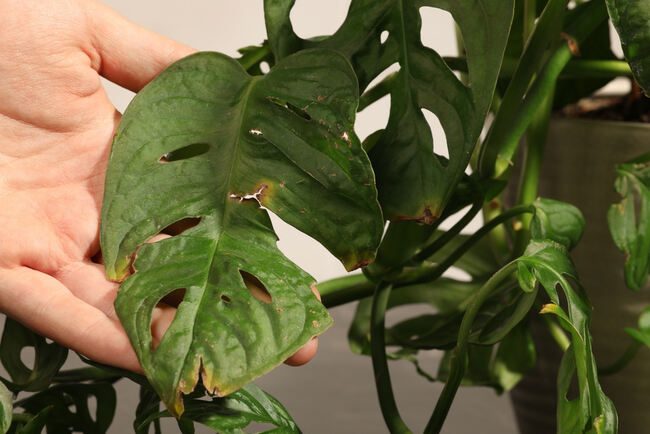
No New Foliage
Are you wondering why your Monstera plant doesn’t grow new foliage? The reason is because it is lacking light. Insufficient light can slow the plant’s growth cycle, causing the plant to grow fewer new leaves. To stimulate young foliages, move the pot to a place with more indirect strong light.
Excess nutrients in the soil can also inhibit new leaf growth, even leading to burning of mature leaves. Adjusting the fertilizing schedule and using a balanced and diluted fertilizer has helped to overcome this problem.
Monstera plants often grow more slowly during the winter due to lack of light and humidity.
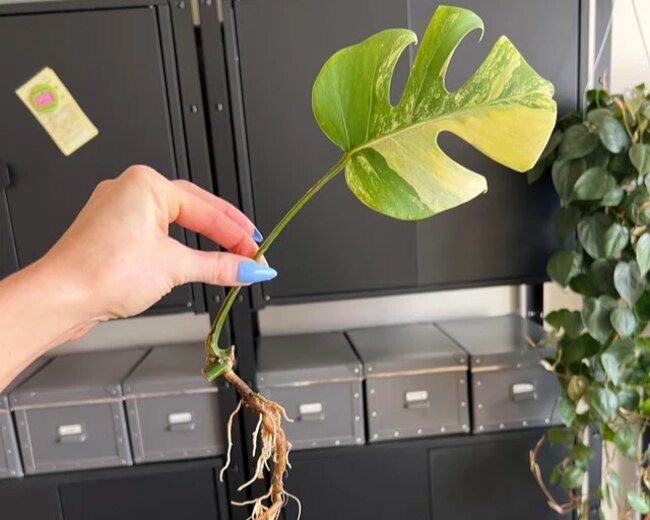
White Spots
The appearance of white spots on leaves can be due to two causes: overexposure to direct sunlight or scale on Monstera. This occurs when Monstera is placed in a location with direct and intense sunlight, causing the chlorophyll in the leaves to decompose, forming white spots or bleaching. You can use blinds or curtains to purify the light in your home to prevent white bleaching on the leaves.
With scales, which are pests that stick to plant leaves and suck the juice out of them. They can make the leaves look white, turn yellow, and grow poorly. You can remove scale insects by spraying them with a product that kills insects on plants or with neem oil.
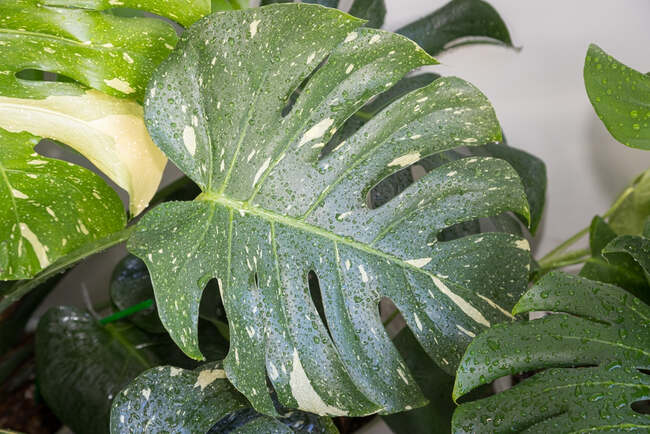
Black Leaves
Leaves infected with fungi or bacteria can cause dark spots, patches or black spots on the leaves, which then slowly spread throughout the entire plant. I treated this problem promptly with fungicide or antibacterial solution according to a famous expert on Youtube.
Again, the mistake of over-watering that I’ve had before. Waterlogged roots lead to root rot and cause the foliage to gradually turn black. Plus, exposing the plant to dry air or sudden low temperatures may cause the leaf turning black color due to heat shock.
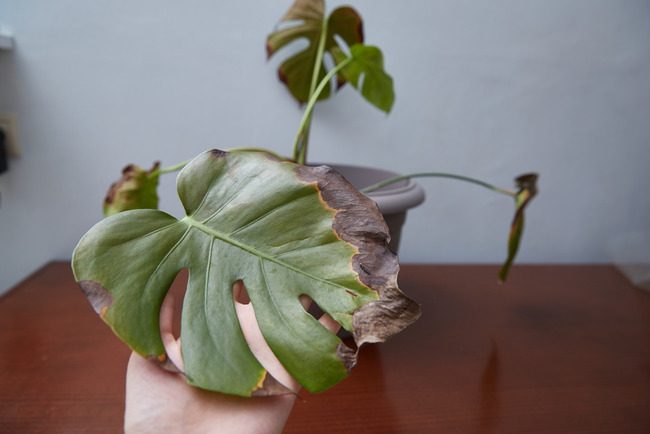
Brown Spots
As I mentioned earlier, brown spots on Monstera leaves can be caused by a variety of factors such as overwatering, over fertilizing, or sunburn from strong unfiltered light. Pests or fungal diseases are also potential causes of leaves turning brown.

Leaves Falling
You can easily see leaf drops in an unhealthy plant. Changes in environmental conditions can cause leaves to fall from trees. For example, when I rearranged the space in my home, I had to move my Monstera pot to a new corner with more light than the original. Unfortunately, it dropped a few leaves on the floor shortly after.
Watering too many times a day or too much water in one watering session can also lead to leaf drop. Conversely, when the soil becomes too dry, Monstera may also shed leaves to conserve moisture.
Another case is when you repot your plant to a new pot or container, this means that its environmental conditions also change including change in soil, pot size, amount of light and humidity. Symptoms of a Monstera plant experiencing repotting shock are yellow leaves, brown patches on leaves, curled foliage, and wilting. Therefore, it is best to maintain the resemblance to the old pot before replacing as much as possible.
When Monstera leaves mature, they also can gradually turn yellow and brown before falling.

Water Dripping
The phenomenon of “water dripping” or sweating on Monstera leaves is often called guttation, when the plant is in a high humidity environment. At night, excess water from plant roots continues to absorb water from the soil, leading to hydathodes. Therefore, you will see leaves that can form dripping water droplets.
I have seen my Monstera sweating when the air in my house is damp. Don’t worry! This is not a concern, but ensure add ventilation during the cold season and avoid over-watering it.

Sunburn
As the name suggests, leaves get sunburned when exposed to direct sunlight and for long periods of time. Signs of sunburn are when you see brown or yellow patches on the leaves. To protect the lush foliage, I only place the Monstera pots where emit indirect light or near a curtained door to filter the light.
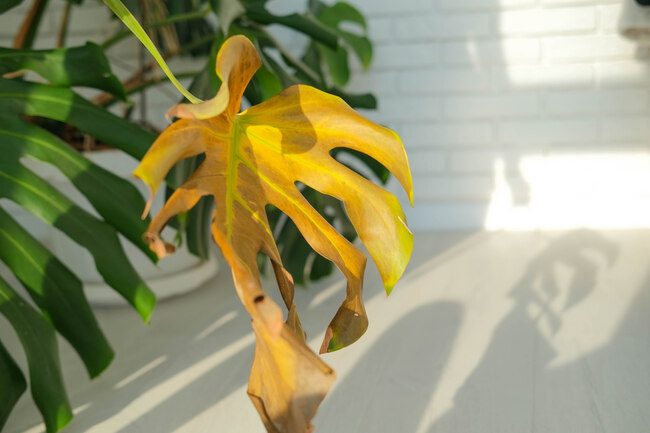
Lack Of Variegation
According to knowledge, plant diversity is normally based on genetic characteristics. Of course, some types of Monstera are naturally variegated in color, while others have solid green leaves, or vary in shape. However, when diverse parts of the plant have difficulty in photosynthesis due to insufficient light, they can become stressed and lose their variegation.
In my experience, balancing ambient conditions is an essential mission to ensure Monstera can maintain their variety. Additionally, cuttings method can be used to propagate multicolored Monstera plants.

Holes On The Leaves
If you see your vibrant green foliage torn or riddled with holes, it could be due to pest attack, fungus or bacterial problems. Pests such as spider mites, aphids or mealybugs can damage leaves by eating plant tissues, which not only leads to the appearance of unsightly holes on the leaf surface, but also affects the development process of their nature. Check the foliage regularly for timely treatment with appropriate solutions.
The holes can be a natural feature of Monstera plants which enables them to adapt and thrive in native rainforest environment.

Monstera Leggy
Monstera plants can become “leggy” when light conditions are insufficient. In my many years of experience growing this plant, I am confident to say it often stretches out to seek more light when it is placed in the shade or when too little light reaches it. Therefore, I always add more lights from the sun or use grow lights. I also prune the foliage periodically to stimulate the growth of new branches and foliage to create an attractive and bushy Monstera pot in my living room.
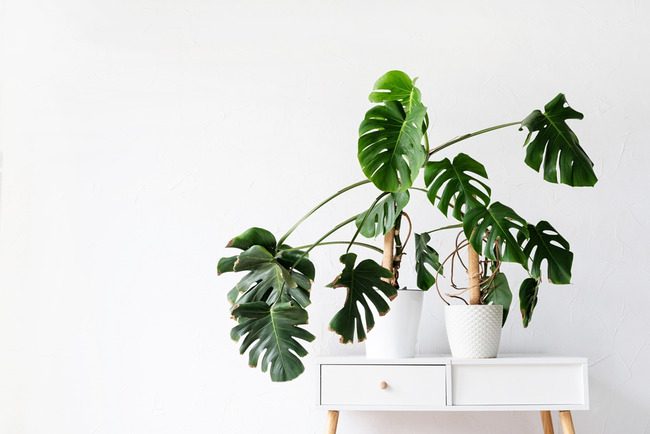
Aerial Root
Natural adaptations to their tropical habitat will form aerial roots in Monstera. Aerial roots are common in helping it climb and cling to trees so it can move towards the light in the forest canopy. It no longer plays an important role in the mechanism of absorbing nutrients and water up the entire plant.
If you’re concerned that these roots are ruining the aesthetics of your Monstera pot, you can prune them at the nodes or stick in the ground to both maintain aesthetics and promote in absorbing nutrients for its growth.

Improper watering
I’ve mentioned a lot about overwatering since the first time, right? Improper watering schedules or soil without adequate drainage are two main reasons for overwatering in Monstera plants. Excessive water amount will cause the root to be soaked in the water for too long, which will eventually lead to yellowing, browning leaf and eventually complete root rot.
Conversely, for underwater Monstera, this directly affects the leaves due to insufficient water supply such as yellowing, brown patches, wilting or curling. Notably, this will result in the rootbound phenomenon. When your plants are thirsty, the roots will often grow out of the drainage holes in search of water, but if its space is too tight, their roots will inhibit growth and form rootbound.
Before watering, check the moisture level by touching the top 1-2 inches of soil to help reduce the risk of root rot. Change your water schedule immediately if you detect the signs of overwatering.

Overfertilized
Similar to humans, overeating will lead to consequences such as obesity, overweight and other diseases. The same goes for plants, if overfertilized plants not only cause nutritional imbalance but also damage the roots.
I often use liquid or diluted fertilizer for ease of use and to limit the risk of over fertilization, while also helping nutrients absorb into the soil faster. Please avoid fertilizers containing high nitrogen ratio since it causes excessive growth, leading to leggy stems and decreasing the aesthetic of your Monstera pot.
Monstera plants require more nutrients in the spring and summer and less in the winter.

Improper Soil
Besides the nutrients in fertilizers, the soil also contains a lot of substances and microorganisms that are beneficial to plants. However, if you choose the wrong type of soil, it will bring negative impacts to the plants. I used to grow Monstera in a potting mix that was available in the storehouse. However, I did not read that this soil mixture is only used for outdoor plants and has poor drainage properties.
The consequence was although it produced some new leaves, they were smaller and had lighter green than expected. And yet, these leaves quickly age and droop, looking very lifeless. When I dug up the roots to check, I discovered that the roots were mushy and brown. Perhaps due to the poor drainage of this soil mix led to such rapid root rot.
If your soil doesn’t drain well, replace it with a more suitable mix. I chose a soil that includes ingredients like perlite, orchid bark, and peat moss. If you suspect root rot, check and cut off the affected parts immediately so as not to kill the entire plant. In addition, Monstera usually likes soil with a pH range between 6 and 7. Use a pH meter to choose the right pH soil concentration.

Rootbound
Rootbound occurs because the roots are restricted by the pot. The pot is too small for the dense growth and development of the roots, making it unable to absorb enough oxygen and nutrients from water and soil. When I lifted up my Monstera roots, what a surprise! I saw the roots curled and pressed together into a mass in the shape of the pot. It took me about 15 minutes to untangle and prune the excess roots, then replant them in a larger container with well-draining soil. This allows the roots more space to grow and absorb nutrients efficiently.
I recommend monitoring and repotting every two years to prevent negative effects from rootbound and give the roots enough space to grow.

Improper Drainage
Anything left in water for too long will corrode and deteriorate. Choosing poor drainage can lead to serious root and leaf problems such as yellow leaves, brown patches, black spots, or even root rot. If you have trouble with the drainage system, quickly repot your plants into well-draining soil. I usually choose the best pots for Monstera on Amazon, and I always prioritize products that come with a tray for excess water and drainage holes.
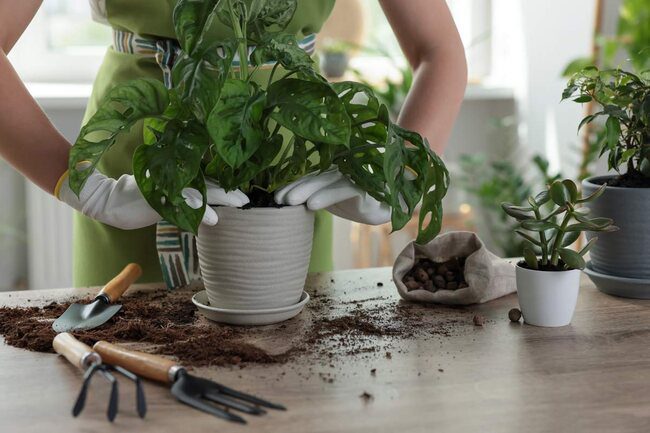
Diseases
These are some of the common signs if your plant is infected such as fungal spotting, discoloration, and white leaves. The cause may be fungal, or thrips infection. To solve these problems, first move diseased Monstera away from healthy plants. Then, prune and remove infected leaves to avoid spreading out the entire plant. Also, adjust humidity levels appropriately and avoid overwatering to make the disease more serious.
I’ve talked about the risk of pathogens from reusing infected pots or using unsterilized garden tools in the “Root Rot” section. This is a factor that I don’t think many people will consider, but prevention is better than cure!
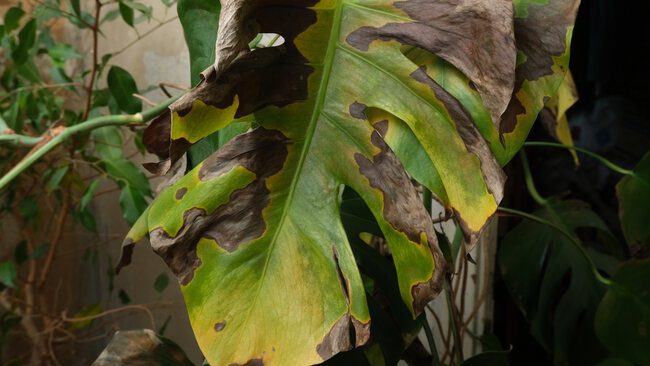
Not Splitting Leaves
Some mature Monsteras may not split because there is not enough indirect sunlight, which prevents ventilation for splitting. To encourage leaf splitting, make sure your Monstera receives enough light and natural growing conditions necessary for leaf splitting.
Don’t fertilize too much in soil because excessive nutrients can make the leaves become larger and unable to separate in half.

Conclusion
I’ve covered all 23 of the most common Monstera plant problems and suggested the methods I’ve used to fix each problem effectively. My potted plants are growing very well now and I hope you also apply my tips I shared successfully. Remember to monitor your plants regularly to promptly remedy and prepare the necessary items in advance. Most importantly, make sure to provide enough growth elements needed to minimize the risks of destroying your beautiful Monstera pots.
FAQs


